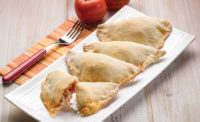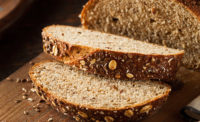A handful of prevailing trends are at work across today’s snack and baking industry to help drive sales forward for foodservice operators, ranging from grain and flavor diversity to an increased focus on health and wellness.
Sandwich inspirations
After Otto Frederick Rohwedder brought his full-loaf bread slicer to market in the 1920s, it was billed as “the greatest forward step in the baking industry since bread was wrapped,” and eventually simplified to “the greatest thing since sliced bread.” About half of all Americans eat a sandwich every day, and permutations of this instant meal circumvent the globe.
Those international inspirations continue to add interest to sandwiches in the U.S. “According to our recently released MenuTrends Keynote, ‘Sandwiches,’ the future of sandwiches is globally inspired,” says Mike Kostyo, senior publications manager, Datassential, Chicago, noting that 10 of the top 15 fastest-growing sandwich varieties on menus are ethnic or regional specialties, like the Vietnamese bánh mì (the top-growing sandwich variety, which has quadrupled in menu penetration since 2012) and the Mexican torta (up 125 percent in the past four years). “The need for carriers that can be used for these globally inspired sandwiches is only going to rise, so both operators and manufacturers should be paying close attention to global bread, bun and roll varieties.”
Upscaling the sandwich carrier can attract patron attention. “Customers are looking for more artisanal products that convey ‘premium’ and command a higher price point from consumers to complement their main menu items,” says Mark Bendix, CEO, East Balt Bakeries, Chicago. “Premium breads and rolls are an important messaging element of the sandwich, because the bread is the first thing a consumer sees, and a value judgment is made.” He also notes that East Balt has been getting more request for slider-style products, likely tied to snacking occasions.
“Consumers demand new and unique flavors in many categories, and when it comes to sandwiches and burgers, operators use unique carriers as one way to satisfy that demand,” says Allison Herold, content and insights analyst, McCormick Flavor Solutions, Hunt Valley, MD. “Instead of a standard sesame seed bun, we are seeing more artisan and better-for-you product bases, such as ancient grain, multigrain and whole-wheat breads, brioche rolls and pretzel buns.” She notes operators are also imparting flavor into the bun itself with offerings like asiago rolls and sriracha buns.
“Bakery-café and sandwich venues are featuring classic, Old World bread flavors such as rye bread, sourdough and brioche,” says Diane O’Marrah, product development scientist, McCormick Flavor Solutions.
Datassential notes that after rolls, wraps are the most-menued sandwich carrier; 31 percent of restaurants that offer sandwiches have a wrap on the menu. But wrap-styled sandwiches have dipped slightly in menu penetration. “Many operators are looking for next-level flatbread options,” says Kostyo. “Naan was the fastest-growing sandwich carrier over the past four years.”
One-third of restaurants have tortillas on the menu, notes Kostyo, with incidence of corn tortillas on the rise. This is partly due to the popularity of street tacos and other options perceived as “authentic.”
Kostyo also notes that opportunities exist for healthy breads and buns. “Consumers overall are interested in healthier sandwich options from operators. Over a third are interested in sprouted-grain breads, for instance, yet they appear on few menus. Breads with clean ingredient lists that offer some type of functional benefit—protein, easy digestion—hit the mark with current consumer trends.”
Sprouted grains are emerging as a way to take bakery items to the next level, suggests Liz Stamp, senior marketing manager, Rich’s Foodservice, Buffalo, NY. “Thought to help with digestion and have an increased level of essential nutrients, sprouted grains is a new way to deliver on consumers’ quests to find food that helps fuel their body.”
Grain diversity overall can capture consumer attention. “Customers are interested in alternative whole grains, such as buckwheat, oats and rye in addition to whole-kernel wheat,” says Sandra Holl, co-owner and executive chef, Floriole Cafe & Bakery, Chicago. She notes that freshly milled, organic grains and long fermentation times bring great flavor to baked goods.
Flavor notes
According to Datassential research, a major trend impacting the breakfast daypart is use of savory flavor notes in traditionally sweet pastries. “Today, half of operators offer some type of savory pastry, and 56 percent of consumers are interested in this trend,” says Kostyo. “Adding a protein, vegetable or cheese to a pastry in lieu of chocolate or jam can give customers a heartier, more-filling option to eat on the go. We’re seeing more savory doughnuts, veggie muffins and globally-inspired options like savory kolaches.”
Kostyo notes that while classic breakfast baked goods like bagels, English muffins, muffins, croissants, Danishes, cinnamon rolls and scones have all been decreasing in menu penetration over the past four years, options like toast, beignets, upscale brioche and Southern biscuits have all been growing.
Johnsonville offers grab-and-go biscuits stuffed with sausage, eggs and cheese, and sausage and gravy, among others, which are particularly well-suited to the convenience store market. They’re snack-sized for easy on-the-go eating.
On the dessert menu, Datassential notes the fastest-growing flavors and typifying ingredients include salted caramel (over 300 percent increase on dessert menus over the past four years), Nutella (up 189 percent), olive oil (up 154 percent) and bacon (up 137 percent). “Gluten-free desserts, however, are easily the fastest-growing options at restaurants, particularly limited-service restaurants,” says Kostyo.
Botanicals are also making their way on to menus, notes David Sattler, market research manager, research and insights, Rich’s Foodservice. “Ingredients such as mint, cardamom, rose and lavender are all being seen on an increasing amount on trendsetting menus.”
Maple flavors are moving into more bakery categories, especially items like doughnuts and cupcakes, notes Herold. “Its popularity is increasing due to its healthy-halo perception as a natural sweetener, an alternative to white sugar.
“The snacking trend leads to products that tend to go one of two ways,” continues Herold, “either very healthful, mindful snacks with high nutrition and lower sugar content, or smaller-portioned indulgences.”
Health on the menu
Oil is a top non-food cost for foodservice operators, so it’s vital to get the most out of its fry life, notes Dave Booher, group leader, healthy oils, Dow AgroSciences, Indianapolis. “The elevated levels of monounsaturated fatty acids in Omega-9 Canola Oil makes it naturally stable, which increases fry life and decreases labor and waste.” He notes that a large Arby’s franchise, which includes five of the top 10 highest-grossing Arby’s locations in the U.S., switched to Omega-9 Canola Oil and decreased oil changes 63 percent per week.
Booher also suggests Omega-9 Canola Oil as an ingredient in baked goods. “The clean taste enables food flavors to shine through, and the fatty acid profile can improve nutritionals and increase shelf life.”
Health angles have grown increasingly important in foodservice. “Omega-9 Canola Oil has high levels of heart-healthy monounsaturated fats, zero grams of trans fat and low levels of saturated fat, which helps consumers meet their personal health goals and dietary guidelines recommendations.”
Health and wellness in foodservice has gone mainstream, impacting frequency of restaurant visits and consumption of products, suggests Pam Smith, RDN, culinary nutrition consultant and author, Orlando. She notes that Stratas Foods, in collaboration with QUALISOY, conducted studies that show that enzymatically interesterified high-oleic soybean oil shortening works well as a drop-in replacement for PHOs for virtually any baking or frying application, including icings and doughnuts. “Interesterification has the ability to produce shortenings, which can be used in a wide range of delicious products without sacrificing the mouthfeel and flavor experience of those produced from partial hydrogenation, including cookies, cakes, spreads, icings and more.”
Combining health halos with verifiable nutritional improvements also helps attract attention. “Clean-label products in their most-natural form and sodium reduction are the largest initiatives we see from our customers globally,” says Bendix.
But, as we see across snack and bakery categories at retail, foodservice menu items—regardless of steps made toward improved health—must offer an enjoyable eating experience. “Healthier options are always desired,” says Bendix, “but there is always the customer contradiction that they want healthier without compromising taste.”








